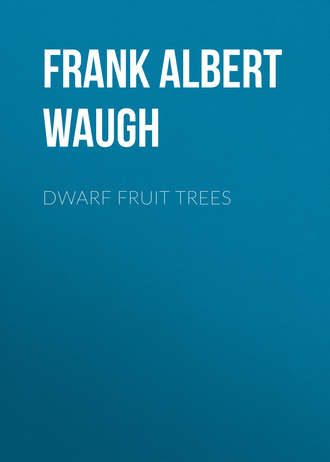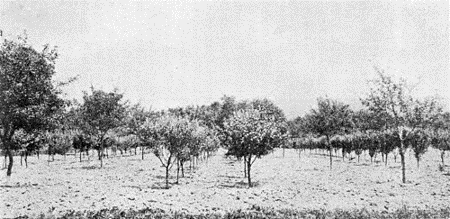 полная версия
полная версияDwarf Fruit Trees
Dwarf pears have been planted frequently, especially in Western New York and Michigan. I asked Professor S. A. Beach for his observations of them, to which he replied: "With regard to dwarf pears I will say that the variety which is most generally grown in commercial orchards is Bartlett. Almost without exception this is grown as a standard. Other important commercial varieties are Seckel, Bosc and Winter Nelis. All these are generally grown as standards. The variety commonly grown as dwarf is Angouleme. A few fruit growers of my acquaintance are making some money from orchards of dwarf Angouleme. The other varieties which are often propagated on dwarf stock as Clairgeau, Anjou and so forth, are seldom profitable. In fact I have heard it stated that outside of Ellwanger and Barry's orchard there is not a profitable orchard of Anjou in this State. From these statements I wish you to derive the conclusion that in New York State under present conditions there is little encouragement for planting dwarf pears commercially."

FIG. 44—IN PROFESSOR BAILEY'S ORCHARD
Chenango apple on Doucin stocks, interplanted between standard trees
Mr. E. W. Wood, for many years chairman of the fruit committee of the Massachusetts Horticultural Society, says that "under the right conditions the dwarf pear tree is a necessity for commercial pear growing. The growers in Revere and Cambridge would feel they could not get along without the dwarf trees. Putting the pear on the quince stock does not change the wants of the roots of the latter, and it is no use setting them on a light, dry soil, as the roots being confined to a small area of unsuitable soil, will make a feeble growth and finally die outright; or, if in an exposed situation, blow over. Most all the varieties may be grown as dwarfs. The Angouleme and Clairgeau, both good market varieties, cannot be successfully grown in any other way."
Recently Mr. M. B. Waite has written me the letter quoted below, giving some conclusions from his experience with dwarf pears in Anne Arundel County, Maryland. He says:
"I planted out 1,000 dwarf pear trees nine years ago. They were largely Duchess (Angouleme), but there are some Manning, Howell, Anjou, Louise Bonne and Lawrence. I have not been entirely satisfied with the results. We have not had the proper quantity of fruit. There has been some fruit every year since the fourth year, and two years ago there was quite a good crop, but nothing to compare with the yield per acre of Kieffer, LeConte and Garber, for instance. Of course, these are higher-priced fruit and large yields are not required for good returns. Only the Duchess and Manning, however, have produced sufficient to pay at all, and the orchard has not as yet really paid financially. We have a nice crop this year, however, more than the total yield up to this season, and perhaps from now on we may win out. My dwarf pears are on a soil too dry and sandy for the best results, and I think we are at Washington pretty near the southern limit, at least at low altitudes. In the mountains of Virginia and North Carolina they can be grown further southward. They require a moist, preferably clay-loam soil even in their naturally favored districts, such as New England, New York and Michigan, but such a soil is still more desirable when rather too far south for their normal range. They require high culture, manuring and fertilizing, and thorough pruning and spraying in any locality, and these requirements are still more exacting in Maryland. A slight neglect in cultivation, pruning or spraying in one season results in a mass of blooms the next spring, but little or no fruit set. Of course, this extra attention which has to be devoted to dwarf pears as compared with Oriental pears, peaches, apples, etc., to be profitable should result in larger yields, but does not usually do so in this latitude. On the other hand, we may say in favor of the dwarf pear that the quince root is a healthy, reliable root for the pear tree; that the trees attain their seasonal growth early, and therefore are not as susceptible to pear blight as standard pears. Furthermore, they are more easily sprayed, pruned, and otherwise handled than the high standard trees."
My friend, Mr. J. W. Kerr, of the Eastern Shore of Maryland, who owns one of the oldest and most picturesque orchards of dwarf pears I ever saw, says that Angouleme (Duchess) is the only variety that pays for growing in that form.
Thus the experience of many men in many parts of America sums up as we began. The conclusion of the whole matter seems to be about this: Dwarf fruit trees have not yet played any prominent role in American commercial horticulture; but they have been profitable in a few special cases, and the probability seems strong almost to the point of certainty that, with the development, refinement and specialization of our commercial fruit growing, a wider field of usefulness will be opened for dwarf trees. In the realm of amateur fruit growing, on the other hand,—a realm now daily widening,—dwarf fruit trees are of capital importance. The owners and renters of small grounds, the cultivators of little gardens—the great majority of American home-makers, in fact,—will find in them an unfailing source of pleasure, inspiration, and even of profit.



